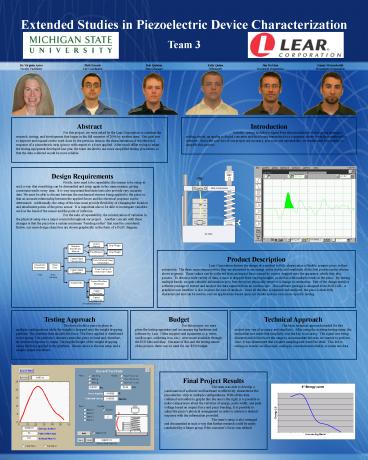Design Requirements - PowerPoint PPT Presentation
1 / 1
Title:
Design Requirements
Description:
... Using Oscilloscope. Screen Captures of Oscilloscope Output. Capture ... a software package to extract and analyze the data captured from an oscilloscope. ... – PowerPoint PPT presentation
Number of Views:35
Avg rating:3.0/5.0
Title: Design Requirements
1
Kelly Quinn Webmaster
Danny Wyrembelski Presentation Preparation
Jim McGinn Document Preparation
Rob Quinlan Team Manager
Phil Gresock Lab Coordinator
Dr. Virginia Ayres Faculty Facilitator
Abstract For this project, we were asked by the
Lear Corporation to continue the research,
testing, and development that began in the fall
semester of 2006 by another team. Our goal was
to improve and expand on the work done by the
previous team in the characterization of the
electrical response of a piezoelectric strip
(piezo) with respect to a force applied. After
much effort trying to adapt the testing equipment
developed last year, the team decided to use more
simplified testing procedures so that the data
collected would be more reliable.
Introduction Initially, testing included a
signal from the piezoelectric device going
through a scaling circuit, an analog to digital
converter and then being transmitted to a
computer, where it was then analyzed by software.
Since the core foci of our project are accuracy,
precision and repeatability, we determined it
necessary to simplify this process.
Design Requirements Firstly, tests need to be
repeatable this means to be setup in such a way
that everything can be dismantled and setup again
in the same manner, giving consistent results
every time. It is very important that these
tests also provide very accurate data. We must be
able to discern between the mechanical stresses
being applied to the piezo so that an accurate
relationship between the applied forces and the
electrical response can be determined.
Additionally, the setup of the tests must provide
flexibility of changing the location and
attachment points of the piezo sensor. It is
important also to be able to investigate
variables such as the bend of the sensor and the
point of inflexion. For the sake of
repeatability, the minimization of variation in
the physical setup was a major concern throughout
our project. Another concern with these changes
is that the piezo has a certain maximum bending
radius that must be considered. Below, our main
design objectives are shown graphically in the
form of a FAST diagram.
Impact Material
Drop Weight
Stimulate Piezoelectric Material
Bend Material
Drop Weight
Product Description Lear Corporation desires the
design of a method to fully characterize a
flexible ceramic piezo in their possession. The
three main characteristics they are interested in
are energy, pulse width, and amplitude of the
first positive pulse (shown above in green).
These values can be collected from an impact
force caused by a mass dropped onto the
apparatus, which they also possess. To obtain a
wide variety of data, a mass is dropped from
varying heights, as well as with multiple bends
in the piezo. By testing multiple bends, we gain
valuable information as to how the piezo
physically reacts to a change in orientation.
Part of the design entails a software package to
extract and analyze the data captured from an
oscilloscope. This software package is designed
from MATLAB. A graphical user interface is also
in place for ease of analysis. Once all the data
is captured and analyzed, the piezo is then fully
characterized and can be used in various
applications based upon our results and any even
more specific testing.
Capture Signal Characteristics
Data Collection Using Oscilloscope
Characterize Piezoelectric
Obtain Data
Screen Captures of Oscilloscope Output
Capture Signal Examples
Task
Basic Function
Capture Waveform Maximums
Analyze Data
Capture Period Data
Capture Energy Data
Secondary Functions
Technical Approach The basic technical approach
needed for this project was one of accuracy and
simplicity. After using the existing testing
setup, the realization was made that simplicity
was the key to accuracy. The signal was being
distorted and did not have the range to
accommodate the tests we wanted to perform.
Also, it was determined that a higher sampling
rate would be ideal. This led to testing on
several oscilloscopes, ending in consistent and
reliably accurate test data.
Budget For this project, we were given the
testing apparatus and accompanying hardware and
software by Lear. Other supplies and equipment
(e.g. wires, oscilloscope, soldering iron, etc.)
were made available through the ECE labs and
shop. Because of this and the testing nature of
the project, there was no need for our 500
budget.
Testing Approach The device holds a piezo in
place in multiple configurations while the weight
is dropped onto the weight dropping platform. The
platform then absorbs the force. The force
applied is distributed to the spring. The
platforms descent causes the piezo to bend and,
therefore, an electrical response is output.
Varying the height of the weight dropping varies
the force applied to the platform. Shown above
is the test setup and a sample output waveform.
Final Project Results The team was able to
develop a combination of software and hardware to
effectively characterize the piezoelectric strip
in multiple configurations. With all the data
collected and added to graphs like the one to the
right, it is possible to make comparisons about
the variation of energy, pulse width, and peak
voltage based on impact force and piezo bending.
It is possible to adjust the piezos physical
arrangement in order to achieve a desired
response with the information provided. The
teams setup is also arranged and documented in
such a way that further research could be easily
conducted by a future group if the customers
focus was refined.































